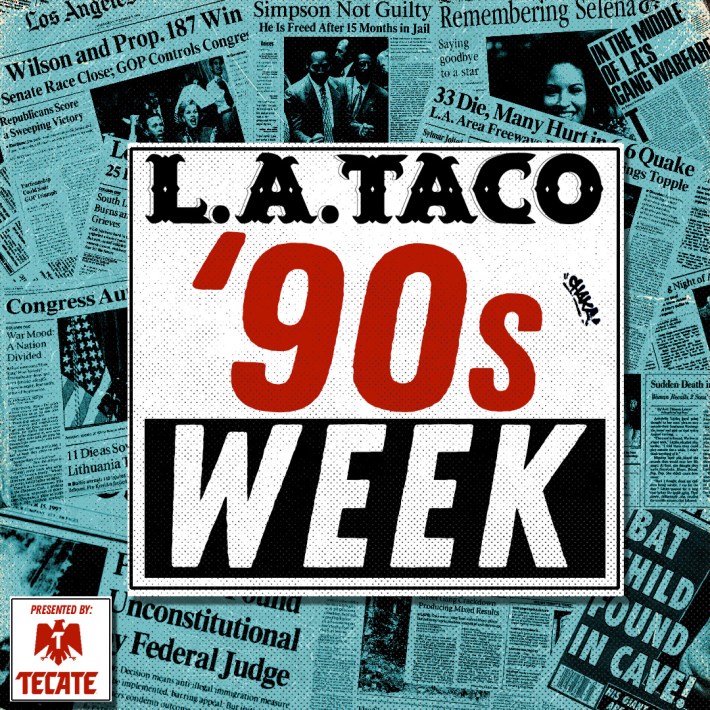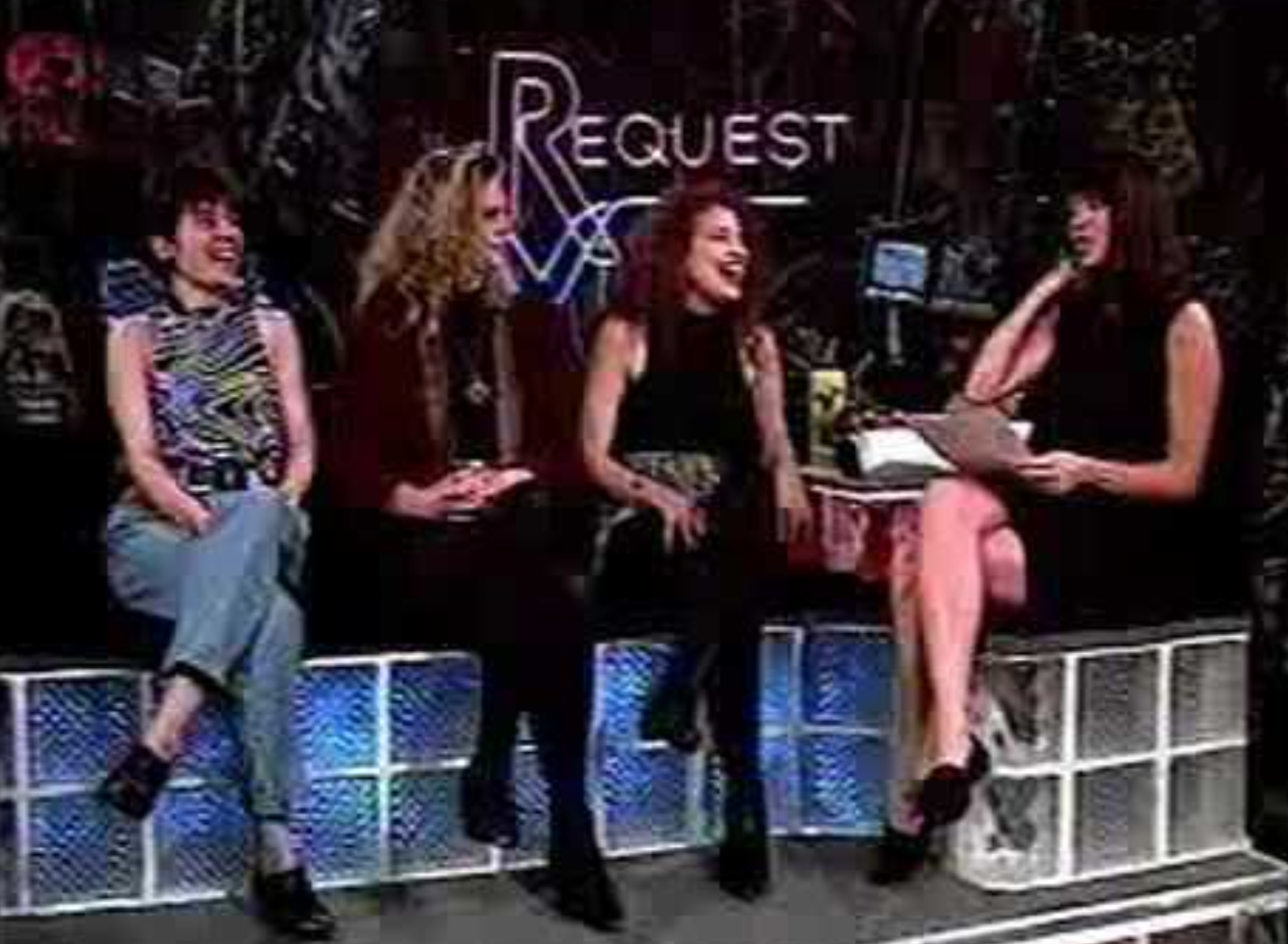
Welcome to our L.A. in the 90s Week, presented by Tecate, the official beer of L.A. TACO. Each day this week, we will bring you features and photo essays celebrating the best of L.A.’s 90s history.
[dropcap size=big]A[/dropcap]s a young teen in the early 1990s, I had one mission after school: gain control of the television set before Request Video began. Maybe you did the same thing. For budding music nerds living in Los Angeles, Orange County, or the Inland Empire, the hour-long music show, which aired weekdays on KDOC 56 from 1987 through 1992, was essential viewing.
It was a pivotal time for music. Hip-hop was in the midst of its golden age. Raves were brewing underground. Alternative music was on the brink of becoming mainstream. Request Video played it all. On any given day, you would tune in not knowing what to expect— maybe Deee-Lite, maybe Joy Division—on a show where the playlist was heavily comprised of requests from across the Southland. The guests similarly crossed genres; Siouxsie and the Banshees, N.W.A., Danzig , and Stacey Q were just some of the artists interviewed on the show. Request Video championed bands local to Los Angeles and Orange County, played videos that MTV wouldn’t touch, and essentially fused together with the Southern California subcultures that existed at the juncture of the 1980s and 1990s.
“A month doesn’t go by where someone doesn’t send me a note talking about what the show’s impact had been or a memory that they wanted to share or tagging me on something,” says Gia DeSantis, who launched Request Video with producing partner Jon Faulkner and served as its host from 1989 through 1992, by phone from Reno, Nevada.
It was one of those strange, beautiful moments in local music history that almost doesn’t make sense.
Request Video came to life at an Orange County television station that was co-owned by Pat Boone and perhaps best known for the conservative talk show The Hot Seat with Wally George. But, the same station was used to film Richard Blade’s show Video One, which aired on channel 9, then KHJ, and the higher-ups decided that KDOC could use something similar. DeSantis and Faulkner, who were already working at the television station, were enlisted to make a show called Request Video. “By the way,” says DeSantis, “We always hated the name.”
DeSantis, who grew up in Los Angeles, had wanted to direct and produce television and left college at 19 to pursue that. Faulkner was a club DJ and previously worked at San Diego’s alternative radio station 91X. To start, they pulled together a group of radio DJs from the region to rotate as hosts for the show, a move that also got Request Video free promotion. Eventually, Jim “The Poorman” Trenton, then with KROQ, took on full-time hosting duties for Request Video. When he left, DeSantis stepped in front of the camera.
“At the beginning, it was almost horrifying,” she recalls. “It was live and I wasn’t particularly comfortable doing it, but I was also trying to step into Poorman’s shoes to a certain degree, which are impossible shoes to fill.”
But, Request Video found its groove. “We really, truly, felt like we were doing it for our friends and their younger siblings,” says DeSantis.
They were also great about bringing together parts of the region that can feel so far removed from each other.
Orange County bands were a big part of the show; Social Distortion’s Mike Ness used to fill in as host and DeSantis still has the first fax she received from The Vandals. Plus, if you watched Request Video, you probably recall seeing No Doubt here long before the band became famous. But, there was a lot of Los Angeles in the show as well. DeSantis’ wardrobe came from Melrose Avenue shop Zulu. Belissa Cohen, then an L.A. Weekly columnist, was a frequent guest. It was a show where those of us who were too young for the clubs learned about bands like Redd Kross and The Muffs.
All this would garner a following that spread across the region. According to DeSantis, Request Video even had a following at Men’s Central Jail. “There was some kind of a weird mandate at the men’s jail downtown that they weren’t allowed to flush the toilets during the time the show was on because it would drown out the audio,” she says.
Toward the end of their run, DeSantis recalls, she had been told by station higher-ups that the show needed to play more mainstream music. Ironically, at this point, the bands that Request Video played, notably Nirvana, had become mainstream. “They felt that we were getting to be too alternative, but what they didn’t understand is that everything had changed and they were just behind the times,” she says. “That was a challenge.”
Not long after that, while she was attending College Music Journal conference in New York, DeSantis got word that the show was canceled, when KDOC halted in-house television production. “For us to lose that outlet, it was hard,” says DeSantis. "It was hard for the viewers.”
DeSantis went on to work in both the music industry and radio and recently served as music director for Nevada Public Radio. But, the Request Video story is still on her mind. Not long ago, DeSantis was contacted by someone regarding an estate sale in Long Beach.
Amongst the items were about 130 episodes of the show on betamax. Then, last year, another person contacted her with about 100 masters of the show retrieved from KDOC. DeSantis then went to the station and was able to buy Request Video— “the intellectual property, the masters, everything,” she says— from them. All this will help in ultimately making a documentary about the show. “It will matter, I think, to a lot of people,” she says.







